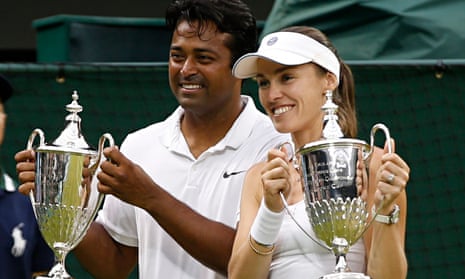Such was Martina Hingis’s excitement at winning her first Wimbledon title in 17 years in the ladies’ doubles on Saturday night that she could not get to sleep until 3am – but if anything she was even more dazzling less than 24 hours later as she and the Indian maestro Leander Paes took the mixed doubles crown.
Between them Hingis and Paes have a combined age of 76 but they were far too clever for the crash-bang tennis of the fifth seeds Alexander Peya and Timea Babos as they galloped to a 6-1, 6-1 victory in just 41 minutes.
In the early part of her career, Hingis was known as the Swiss Miss. But that moniker was entirely inappropriate on an evening where she was instrumental in producing one of the most dominant performances on Centre Court of these entire championships. It was so good it could be released as an instructional DVD on how to play mixed doubles tennis.
“My body was hurting here, there and everywhere but the adrenaline got me back out there,” said Hingis, who took the ladies’ doubles with her partner Sania Mirza. “So to also bring this title home was incredible.”
As she spoke Paes nodded before adding his own tribute. “Everyone knows what Martina has achieved over the years at Wimbledon. To come out there and do it back to back, the physical and mental effort that it takes to win two titles in the same week, is something really, really special.”
Hingis’s story loses nothing in its retelling: she claimed her first ladies’ doubles title at Wimbledon in 1996 aged 15, and became the youngest singles’ champion in 110 years when she won the title aged 16 years and nine months. But after winning six grand slam titles and nine women’s doubles titles she retired at 22 after two ankle surgeries. She returned in 2005 and climbed into the top 10, but was banned for two years in 2007 after testing positive for cocaine. And now she is back again, just two months short of her 35th birthday, as arguably the best women’s doubles player in tennis.
And what is even more impressive is that in an era of power tennis, Hingis is a glorious throwback. She strokes the ball rather than throttles it, but her extra-sensory powers of anticipation combined with a mathematician’s appreciation of angles makes her absolutely formidable on a doubles court. Her volleying at the net stood up to everything that the muscular Peya, in particular, threw at her.
In mixed doubles the women’s serve is the most threatened because it is slower. But while the Hingis serve was the slowest on court, Paes’ timing at the net was staggering. Repeatedly Hingis would get a first serve in and the 42-year-old Paes would anticipate the return to put away a winner. As Hingis put it afterwards: “He was striking winners right and left. I was like: OK, if I can just keep up with him a little bit. The chemistry we had was incredible.”
Hingis and Paes broke early and won their first 10 points on serve to race to a 4-1 lead. Another break of serve meant they were 5-1 up in 17 minutes and the first set followed two minutes later.
Paes appears to have got better with age: 12 of his 16 grand slam men’s doubles and mixed doubles titles have come in his 30s and 40s, and he became the oldest man to ever win a grand slam title when he and Hingis won the mixed doubles at the Australian Open in January. The hour of yoga she does every day surely helps.
The second set was just as one-sided. Just before halfway through it, there was a particularly telling statistic – Paes and Hingis had won 100% of their second-serve points, while Peya and Babos had managed just 14%. In truth, though, Paes and Hingis dominated everywhere. It seemed entirely appropriate that Paes sealed victory in 41 minutes with a masterful disguised return – and that they celebrated the standing ovation from the crowd by signing tennis balls and hitting them into the stands.
This was Paes’ fourth Wimbledon mixed doubles title – with four different partners – while Hingis was claiming her first. Afterwards Paes reflected on another of those wins, with Martina Navratilova in 2003, as he compared what he called “two legends of the game.”
“They’re both the two greatest female athletes in the planet that we have had in any sport,” he said. “In tennis Martina Navratilova and Martina Hingis are right at the top. Hingis probably has the best groundstrokes or return of serves I have ever seen. I still learn from her.”
Hingis now has five singles and 11 doubles titles to her name, but she is not finished yet. Afterwards she admitted she wanted to play in the mixed doubles at the Rio Olympics next year – and on this evidence whoever wins the battle between Roger Federer and Stan Wawrinka to play with her will be halfway towards a gold medal.

Comments (…)
Sign in or create your Guardian account to join the discussion